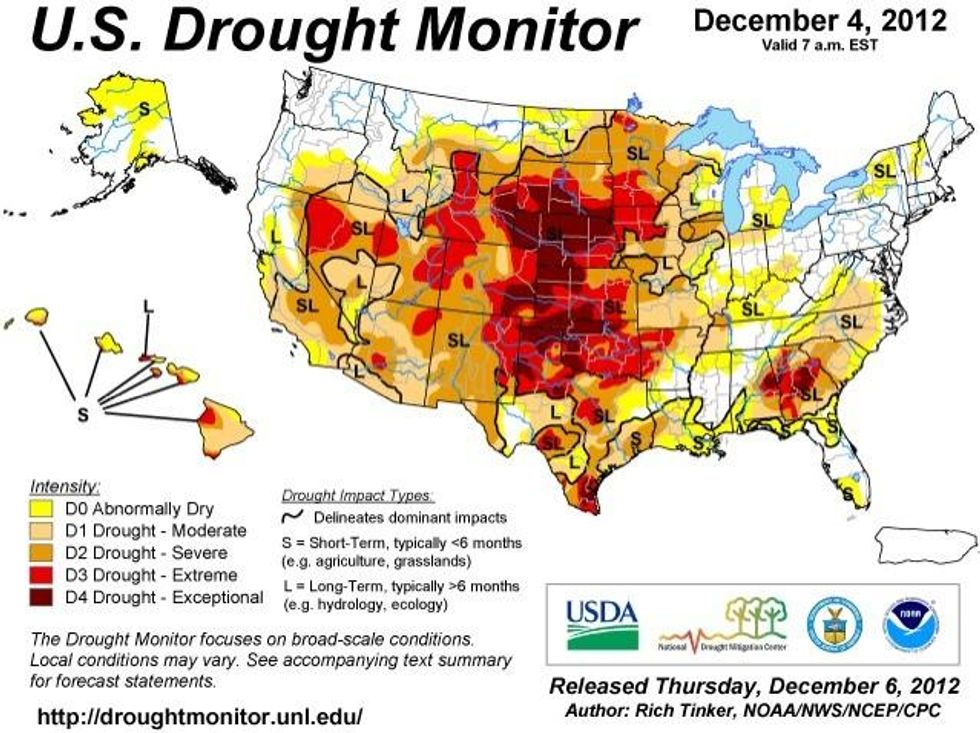

SUBSCRIBE TO OUR FREE NEWSLETTER
Daily news & progressive opinion—funded by the people, not the corporations—delivered straight to your inbox.
5
#000000
#FFFFFF
To donate by check, phone, or other method, see our More Ways to Give page.


Daily news & progressive opinion—funded by the people, not the corporations—delivered straight to your inbox.

2012 is nearly certain to be the warmest year ever for the US, according to the latest figures from the NOAA.
It would take December being more than 1.0degF colder than the coldest December recorded in 1983 in order for 2012 not to be the nation's warmest year ever, the latest monthly climate analysis released Thursday from NOAA's National Climatic Data Center (NCDC) shows. As Philip Bump notes at Grist, "Unless hell freezes over, 2012 will be the hottest year in U.S. history."
1998 currently holds the record for hottest year in the US.
Even before the final weather data for the year is in, the first 11 months of 2012 are record breaking. The NCDC shows January-November 2012 as the warmest such period on record.
The US Climate Extremes Index (USCEI) was more than twice the average value during the 11-month period as well, as a result of warm daytime and nighttime temperatures and drought conditions.
The last 12 months, December 2011-November 2012, were the warmest such 12-month period on record for the contiguous US, with the average temperature 3.2degF above average.
As for the month of November, the NOAA writes that "the word of the month is 'dry.'"

The month saw the nationally-averaged precipitation total nearly an inch below the long-term average, and the snow cover for the month was below average.
"According to the November 27, 2012 U.S. Drought Monitor report, 62.7 percent of the contiguous United States was experiencing moderate-to-exceptional drought, larger than the 60.2 percent at the end of October," the NCDC reports.
The High Plains is particularly parched, with the most recent figures showing over 93% of region in some level of drought. Within that dry region is Colorado, where a wildfire has continued to burn for nearly two months.
Looking ahead through the month of February, drought conditions are expected to persist for much of the nation.
The drought continues to have a devastating impact on the nation's agriculture. The New York Times reports:
Just over a quarter of the nation's wheat crop, planted mostly in September and October, was in poor or very poor condition, according to a report released last week by the United States Department of Agriculture. Those are the worst conditions since the department began keeping records in 1986, said Brad Rippey, a meteorologist with the department.
In Nebraska, where most of the state has been in an exceptional drought, farmers have reported planting their wheat in dry soil with the hope that rain or snow will eventually come and germinate the seeds and allow them to sprout, said Caroline Brauer, a spokeswoman for the Nebraska Wheat Board.
But for now, in some dehydrated fields, thin, green whiskers resembling grassy patches poke from the dusty ground, rather than the thick, wavy plants that typically sprout from a healthy wheat field.
The Times quotes David Miskus, a meteorologist with NOAA's climate prediction center, who says, "It's not looking very promising right now."
Dear Common Dreams reader, The U.S. is on a fast track to authoritarianism like nothing I've ever seen. Meanwhile, corporate news outlets are utterly capitulating to Trump, twisting their coverage to avoid drawing his ire while lining up to stuff cash in his pockets. That's why I believe that Common Dreams is doing the best and most consequential reporting that we've ever done. Our small but mighty team is a progressive reporting powerhouse, covering the news every day that the corporate media never will. Our mission has always been simple: To inform. To inspire. And to ignite change for the common good. Now here's the key piece that I want all our readers to understand: None of this would be possible without your financial support. That's not just some fundraising cliche. It's the absolute and literal truth. We don't accept corporate advertising and never will. We don't have a paywall because we don't think people should be blocked from critical news based on their ability to pay. Everything we do is funded by the donations of readers like you. Will you donate now to help power the nonprofit, independent reporting of Common Dreams? Thank you for being a vital member of our community. Together, we can keep independent journalism alive when it’s needed most. - Craig Brown, Co-founder |

2012 is nearly certain to be the warmest year ever for the US, according to the latest figures from the NOAA.
It would take December being more than 1.0degF colder than the coldest December recorded in 1983 in order for 2012 not to be the nation's warmest year ever, the latest monthly climate analysis released Thursday from NOAA's National Climatic Data Center (NCDC) shows. As Philip Bump notes at Grist, "Unless hell freezes over, 2012 will be the hottest year in U.S. history."
1998 currently holds the record for hottest year in the US.
Even before the final weather data for the year is in, the first 11 months of 2012 are record breaking. The NCDC shows January-November 2012 as the warmest such period on record.
The US Climate Extremes Index (USCEI) was more than twice the average value during the 11-month period as well, as a result of warm daytime and nighttime temperatures and drought conditions.
The last 12 months, December 2011-November 2012, were the warmest such 12-month period on record for the contiguous US, with the average temperature 3.2degF above average.
As for the month of November, the NOAA writes that "the word of the month is 'dry.'"

The month saw the nationally-averaged precipitation total nearly an inch below the long-term average, and the snow cover for the month was below average.
"According to the November 27, 2012 U.S. Drought Monitor report, 62.7 percent of the contiguous United States was experiencing moderate-to-exceptional drought, larger than the 60.2 percent at the end of October," the NCDC reports.
The High Plains is particularly parched, with the most recent figures showing over 93% of region in some level of drought. Within that dry region is Colorado, where a wildfire has continued to burn for nearly two months.
Looking ahead through the month of February, drought conditions are expected to persist for much of the nation.
The drought continues to have a devastating impact on the nation's agriculture. The New York Times reports:
Just over a quarter of the nation's wheat crop, planted mostly in September and October, was in poor or very poor condition, according to a report released last week by the United States Department of Agriculture. Those are the worst conditions since the department began keeping records in 1986, said Brad Rippey, a meteorologist with the department.
In Nebraska, where most of the state has been in an exceptional drought, farmers have reported planting their wheat in dry soil with the hope that rain or snow will eventually come and germinate the seeds and allow them to sprout, said Caroline Brauer, a spokeswoman for the Nebraska Wheat Board.
But for now, in some dehydrated fields, thin, green whiskers resembling grassy patches poke from the dusty ground, rather than the thick, wavy plants that typically sprout from a healthy wheat field.
The Times quotes David Miskus, a meteorologist with NOAA's climate prediction center, who says, "It's not looking very promising right now."

2012 is nearly certain to be the warmest year ever for the US, according to the latest figures from the NOAA.
It would take December being more than 1.0degF colder than the coldest December recorded in 1983 in order for 2012 not to be the nation's warmest year ever, the latest monthly climate analysis released Thursday from NOAA's National Climatic Data Center (NCDC) shows. As Philip Bump notes at Grist, "Unless hell freezes over, 2012 will be the hottest year in U.S. history."
1998 currently holds the record for hottest year in the US.
Even before the final weather data for the year is in, the first 11 months of 2012 are record breaking. The NCDC shows January-November 2012 as the warmest such period on record.
The US Climate Extremes Index (USCEI) was more than twice the average value during the 11-month period as well, as a result of warm daytime and nighttime temperatures and drought conditions.
The last 12 months, December 2011-November 2012, were the warmest such 12-month period on record for the contiguous US, with the average temperature 3.2degF above average.
As for the month of November, the NOAA writes that "the word of the month is 'dry.'"

The month saw the nationally-averaged precipitation total nearly an inch below the long-term average, and the snow cover for the month was below average.
"According to the November 27, 2012 U.S. Drought Monitor report, 62.7 percent of the contiguous United States was experiencing moderate-to-exceptional drought, larger than the 60.2 percent at the end of October," the NCDC reports.
The High Plains is particularly parched, with the most recent figures showing over 93% of region in some level of drought. Within that dry region is Colorado, where a wildfire has continued to burn for nearly two months.
Looking ahead through the month of February, drought conditions are expected to persist for much of the nation.
The drought continues to have a devastating impact on the nation's agriculture. The New York Times reports:
Just over a quarter of the nation's wheat crop, planted mostly in September and October, was in poor or very poor condition, according to a report released last week by the United States Department of Agriculture. Those are the worst conditions since the department began keeping records in 1986, said Brad Rippey, a meteorologist with the department.
In Nebraska, where most of the state has been in an exceptional drought, farmers have reported planting their wheat in dry soil with the hope that rain or snow will eventually come and germinate the seeds and allow them to sprout, said Caroline Brauer, a spokeswoman for the Nebraska Wheat Board.
But for now, in some dehydrated fields, thin, green whiskers resembling grassy patches poke from the dusty ground, rather than the thick, wavy plants that typically sprout from a healthy wheat field.
The Times quotes David Miskus, a meteorologist with NOAA's climate prediction center, who says, "It's not looking very promising right now."